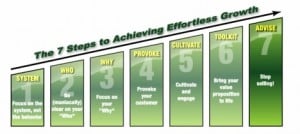 I remember it like yesterday. There were 600 people in the crowd, and I was center-stage where noted sales trainer Tom Hopkins was quizzing me on closing techniques and overcoming objections. As I recited the closes word-for-word, I was well on my way to being what I thought was a champion closer.
I remember it like yesterday. There were 600 people in the crowd, and I was center-stage where noted sales trainer Tom Hopkins was quizzing me on closing techniques and overcoming objections. As I recited the closes word-for-word, I was well on my way to being what I thought was a champion closer.
I have to admit my ability to recite 30 closes on command gave me a lot of confidence when entering sales situations. I’d go into meetings ready for a “no.” I felt as though the prospect would have to have at least 31 ways to say no, because I had 30 ways to get them to say “yes.”
While I certainly put up successful sales numbers with this approach, it caused tremendous collateral damage – on me and my prospects and customers. It was a grind, and it became progressively less effective as the world became more complex, buying processes became more involved and my competitors got increasingly aggressive.
The fundamental problem with my approach was that I was spending far too much time trying to convince people to do things, rather than enabling them to discover the need to move forward themselves.
The entire basis of good sales is making sales to people who should be doing what you are asking them to do. If what you want is good for them, then you shouldn’t have to convince anyone of anything. The more you try to convince, the more defensive your prospects and customers will be.
This led to the discovery of the one step that has had more impact on shortening my sales cycle and increasing my win rate, than any thing else I have done.
I simply stopped talking about the value of doing business with me, and instead enabled people to understand the cost of not doing business with me. I stopped focusing on solutions and benefits, and started focusing on consequences and impact.
I developed tools like The Cost Calculator Worksheet that allowed me to lead my prospects to discover and understand their problems, and the impact of both solving and failing to solve those problems. As I shared in last week’s post, I stopped telling people about how great doing business with me was, and allowed them to experience it.
If you think about it, there’s only one reason people don’t do business with you. That reason is they don’t see the consequences of not doing business with you. Given that, I simplified everything on focused on that. From there, everything else took care of itself.

 Doug Davidoff
Doug Davidoff